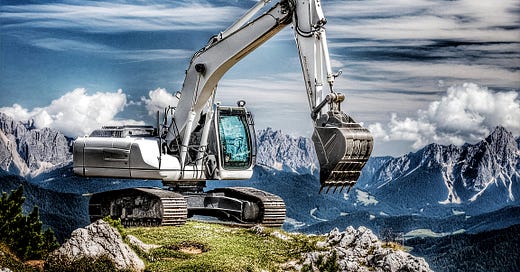Have we peaked...?
Is the demolition and construction equipment of today as good as it is ever likely to get?
When did you last attend an industry exhibition or event and see a new product that stopped you in your tracks with its innovation and ingenuity? When was the last time you discovered a new machine or solution on YouTube that was so startling you just had to share it with your colleagues? When did you last open an industry magazine and think to yourself “Wow! I have never seen that before?” (Come to think of it, when did you last open an industry magazine?)
If you’re anything like me, it has probably been a while. For all the hype, excitement and anticipation surrounding the recent Intermat exhibition in Paris, I found very little to take my breath away; very little that signalled a real change in direction. All around was evolution rather than revolution; variations on long-established themes; more of the same.
Oh sure, some of the kit had got bigger; some of it was faster or more economical. Some of it was on the cusp of abandoning diesel in place of electric or hydrogen fuel. But excavators were still the same shape they have always been; wheel loaders were still a bucket at the front, a counterweight at the rear and a cab placed somewhere between the two. For all their rounded edges and design aesthetics, dozers of today look pretty much identical to the dozers of 20 or even 30 years ago.
So. Has the industry peaked? Have we taken design and innovation as far as we possibly can? Will all future machines, henceforth, be merely incrementally better than its predecessor?
Personally, I do not think we have peaked. The minds of the equipment manufacturers will continue to be taxed by whatever alternative eventually replaces diesel as our primary fuel source. A failure to address an ever-deepening skills shortage coupled with a desire to keep men (and women) out of harm’s way surely means that development of autonomous machines will continue and accelerate well into the future. And new applications (offshore rig dismantling, mechanised soft strip and clearing the way for refurbishment, to name but a few) will surely engender further tangential innovation.
The key obstacle to true ground-breaking innovation is that, after almost a century, equipment types are well established and their function-matching-form is both proven and mature. Another reason for an apparent slowing in true innovation has been brought about by the manufacturers themselves; and it comes in two parts.
The first part is that there is now a widespread commonality of parts between many of the major equipment brands. They each get their engines from the same supplier; they each get their transmissions from the same supplier; they each share a preferred hydraulic pump provider. Machines are, therefore, so evenly matched that the industry has become like Formula 1 racing; a ceaseless procession of machines that are almost identical with one team having just a slight advantage for a year until their rivals catch up or overtake.
The second part of the problem is that, in many instances, machine development has descended into a session of “keeping up with the Joneses”; a poker game in which one manufacturer introduces bluetooth connectivity and is immediately met with a cry of “we see your bluetooth connective and we raise you a cup holder.” And so the game goes along.
Despite all this, I am looking forward to seeing what’s new at Bauma in 2025 and at ConExpo in 2026. There is a part of me that believes that in a top secret skunk works somewhere in the world, the industry’s “next big thing” is sitting on a drawing board, waiting patiently for its moment to burst onto the scene.
For now though, I believe we may have seen the last of the revolutionary “giant leaps” for the industry. For the time being, we may just have to content ourselves with evolutionary pigeon steps.





